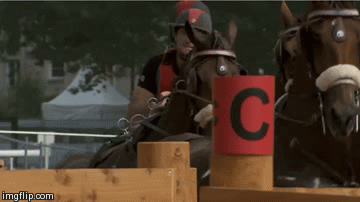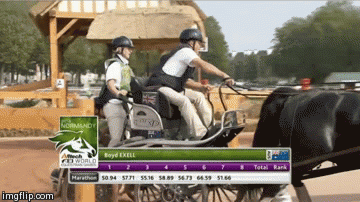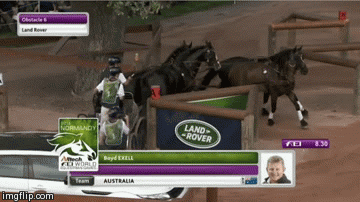Demystifying Combined Driving: WEG Day 2 (really 3)
Because eventing with one horse just wasn’t crazy enough, let’s do it with 4. (And a carriage.) Day 2 (but actually day 3 at WEG): marathon.
Following a similar format as three-day eventing, today’s WEG combined driving competition turned its sights to the marathon course. The marathon portion of combined driving includes two sections: a pace course similar to a roads-and-tracks route where competitors trot their teams of four over a prescribed course several kilometers long, and the obstacles course, where competitors accumulate time and penalties over eight obstacle combinations. Time between obstacles is not counted towards the overall time.

The Rolex Obstacle Complex. To quote my fiancé looking over my shoulder: “It’s…like the Hunger Games. Have they spun it around yet so no one knows where they’re going?”
Obstacles in the case of marathon don’t refer to solid natural jumps as they do in eventing, but a series of gates through immobile hazards that should be navigated with speed and precision. Obstacle complexes usually make the most of the natural slope of environment as well as water and bridges, and are designed to test a team’s agility, obedience, stamina and speed. The challenge for the course designers at this year’s venue, La Prarie racecourse, was finding a way to use the famous trotting track (which is quite flat) and bring it to life for marathon–the resulting course challenging drivers’ overall horsemanship and management as well as driving capabilities. Several competitors referred to the length of stud they decided to use, and Australian Boyd Excell even sent back to his homeland to have a different set of wheels shipped for his carriage to give him better grip on the flat and well-groomed surface.
In the first installment of this series, I mentioned the grooms as part of the driving team–in dressage, they don’t do anything except literally sit still silently and look good. In marathon, however, the grooms are a critical part of the operation: one groom rides (usually standing and hanging on) just behind the driver and serves as a navigator, meaning that they need to know the course inside and out as much as the driver does to help pick out the correct gates in the proper order. The second groom clings to the back of the carriage for dear life and acts as a counter-weight, leaning his or her weight in the turns to either help the carriage drift around a tricky spot or sometimes to help keep the carriage from rolling right over. And when the carriages drift, I’m taking serious dirt-slinging Tokyo drift:
This ain’t your Victorian-era ladies picnic class any more.
The kind of teamwork required among the four horses floors me every time I watch a team expertly weave through an obstacle complex–there’s clearly so much trust going on between driver and horses as each relies heavily on the other to get through marathon alive. The driver as well as his grooms use a lot of verbal communication; as each team navigates an obstacle there’s a ton of yelling from driver to horses, or navigator to driver, or possibly all three humans yelling at each other or the horses, and somehow it all makes sense to everyone. Still, that doesn’t mean there are occasionally a few mistakes, like this moment when Boyd Excell got his carriage stuck in a complex for a few moments, costing him precious seconds on course:
Still, despite a few such mishaps, overall it was amazing to watch all of the WEG competitors transition from yesterday’s top hats and formalities to today’s down-and-dirty intensity. Tomorrow’s cones portion–modeling the test of stadium jumping after a long and tiring day on the marathon course–brings yet another aspect to combined driving, and an exciting conclusion to today’s competition which joined battle again between two international driving titans, the USA’s Chester Weber and Australia’s Boyd Excel. Medals will be decided on the cones course Sunday morning!
Go driving!









Leave a Comment